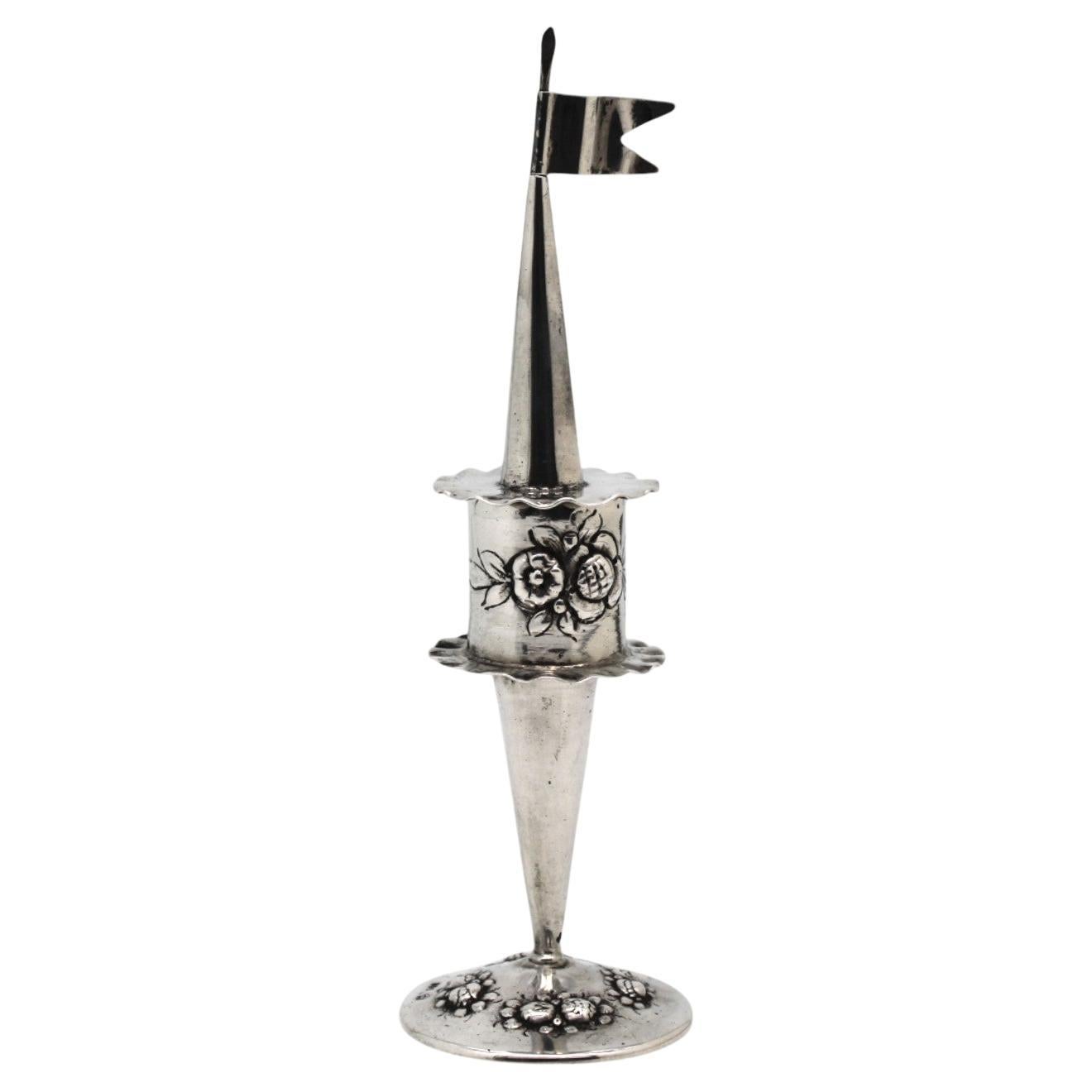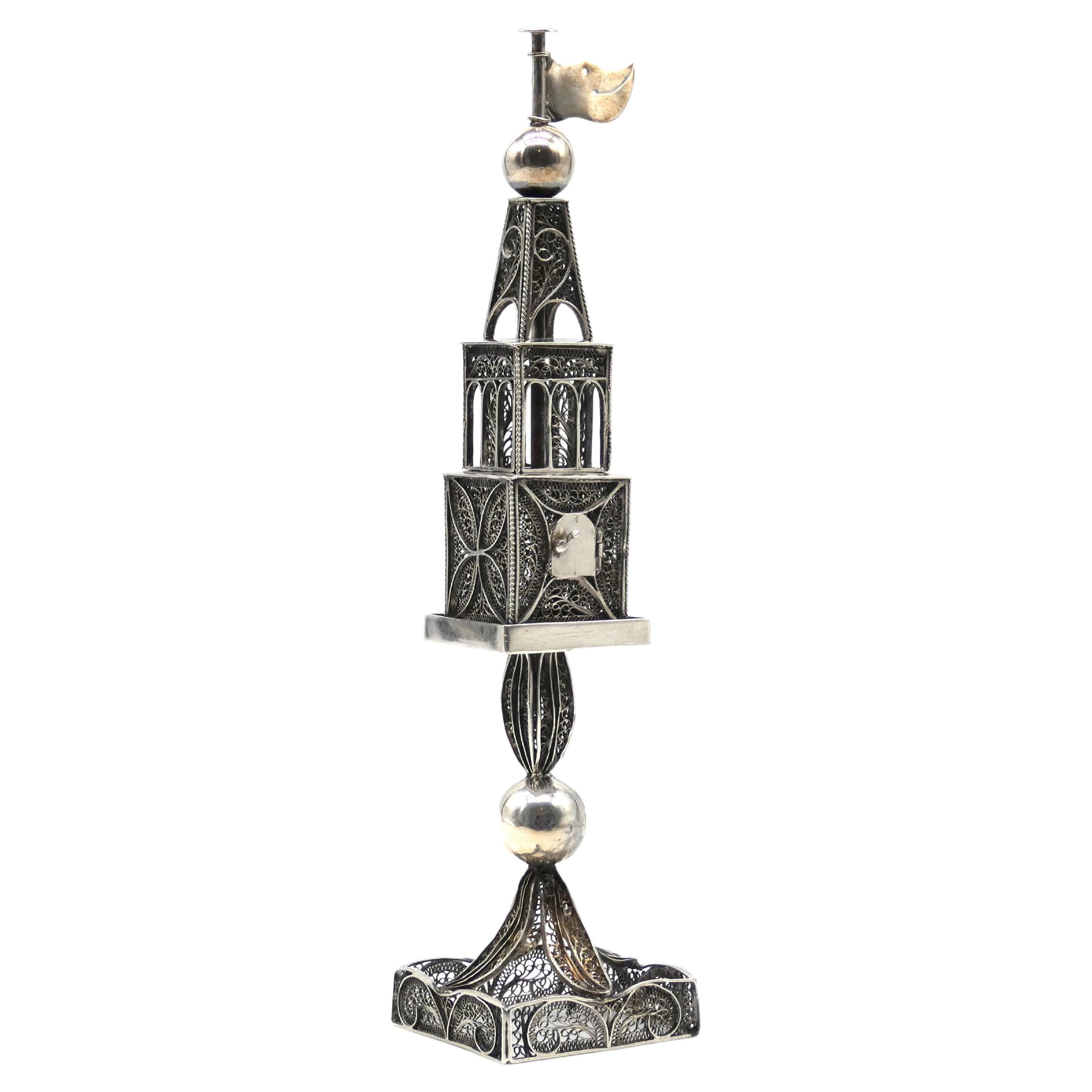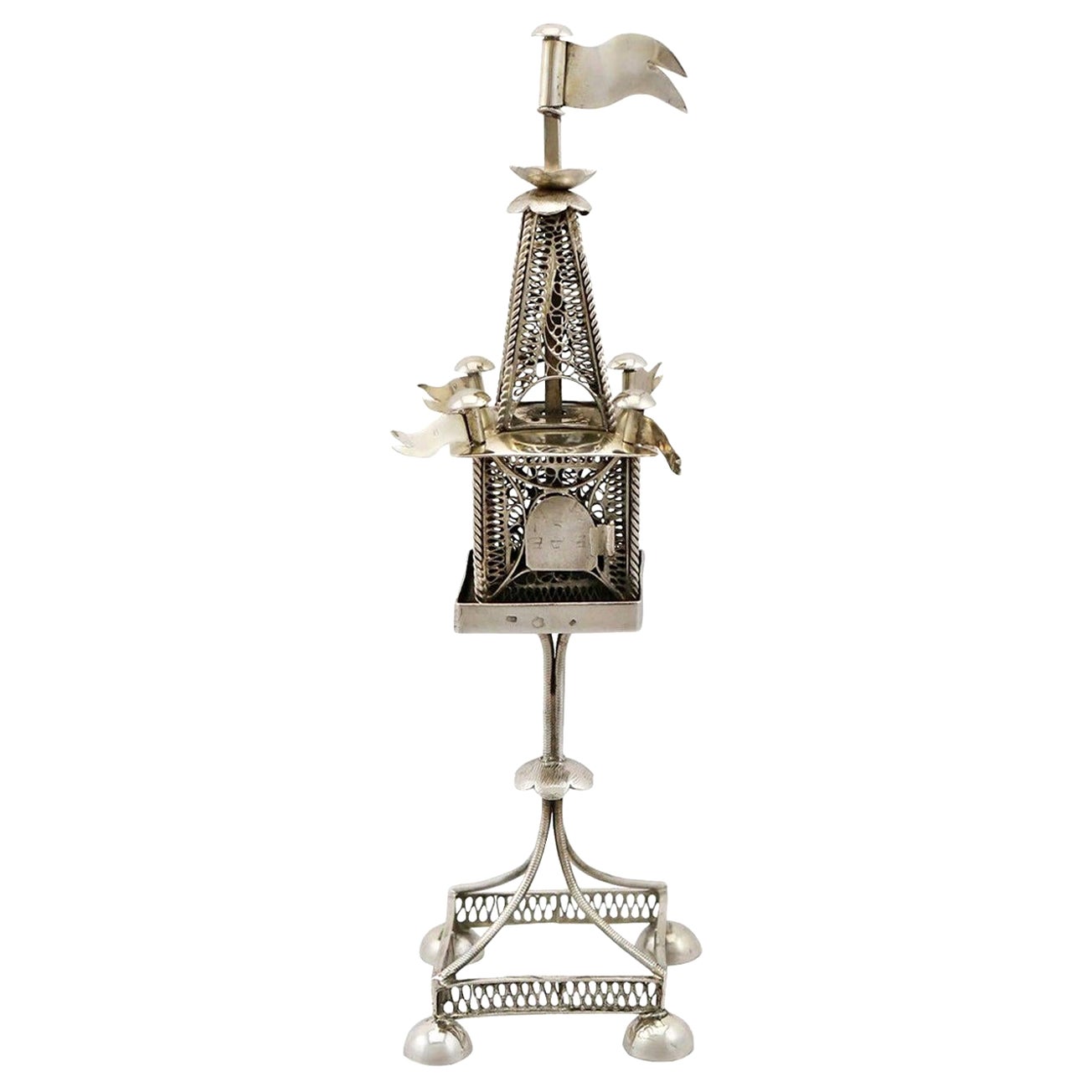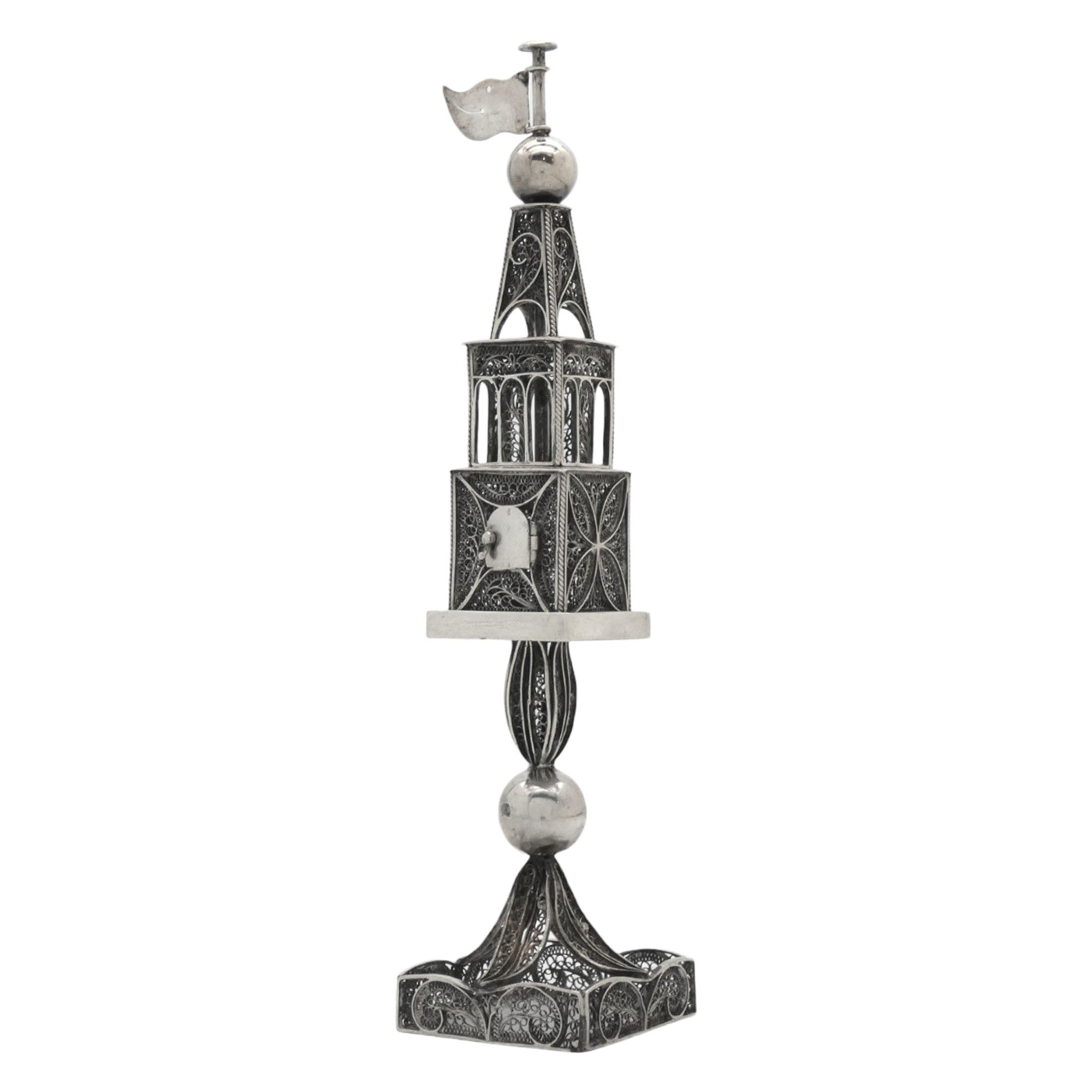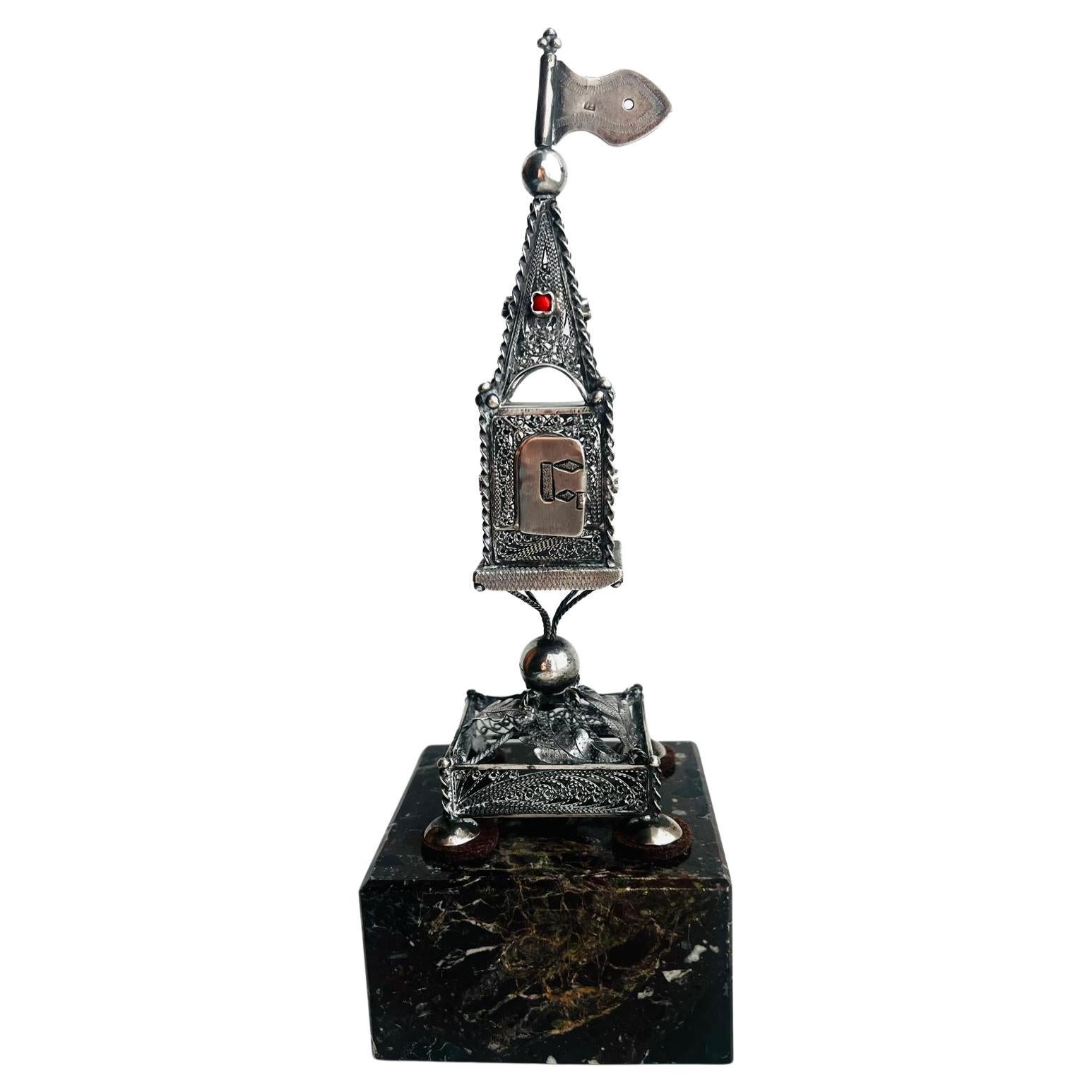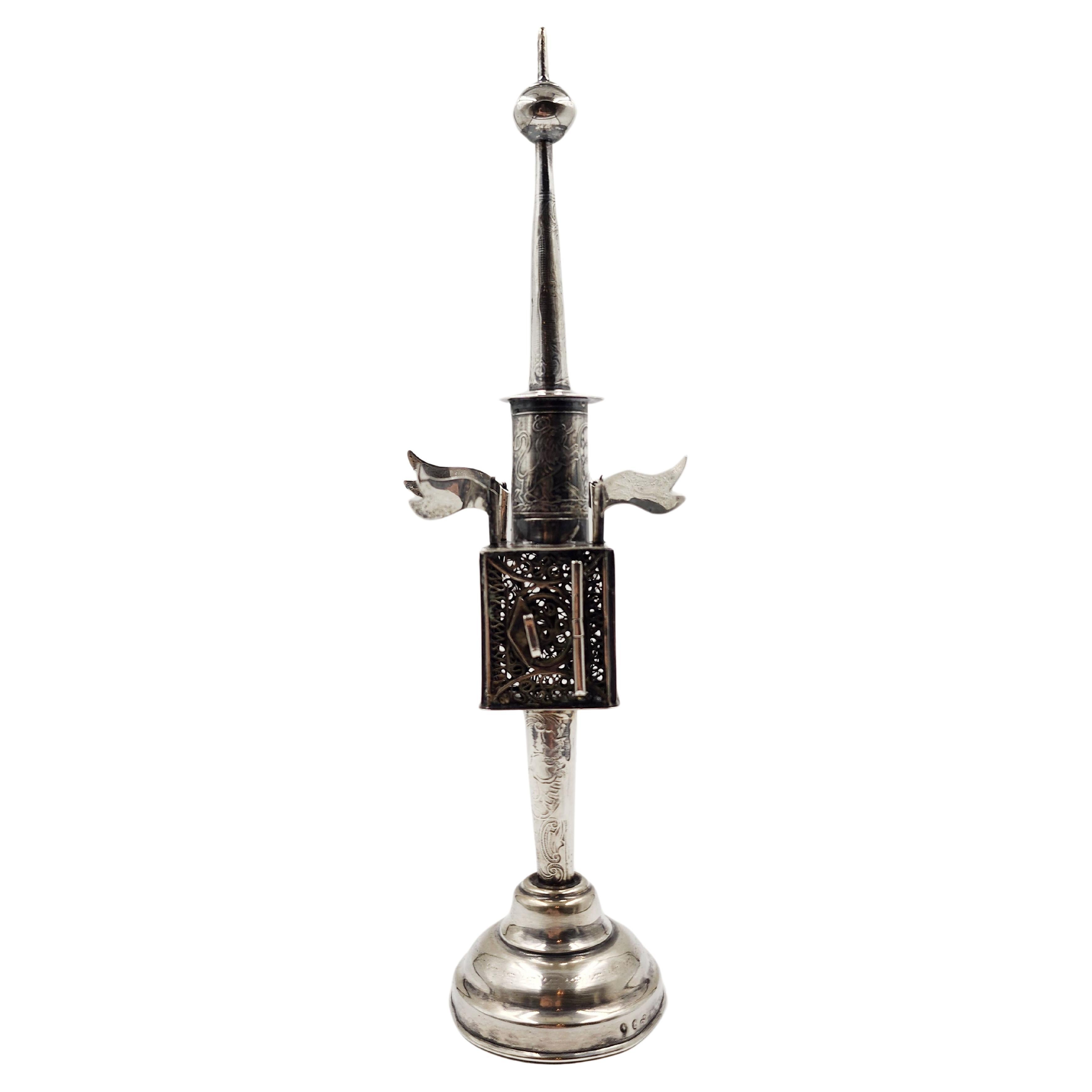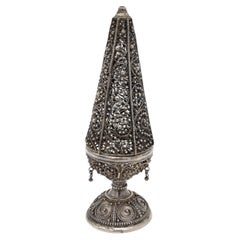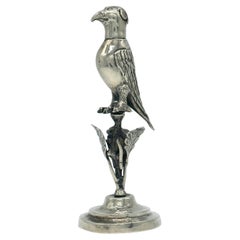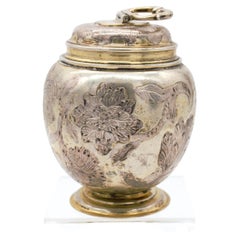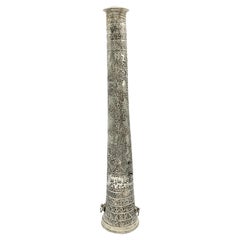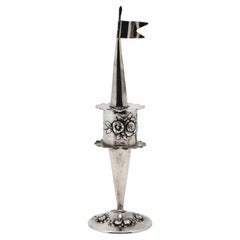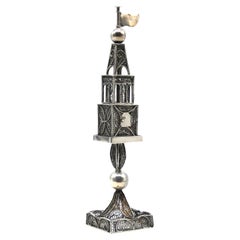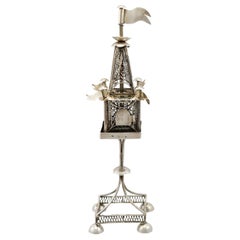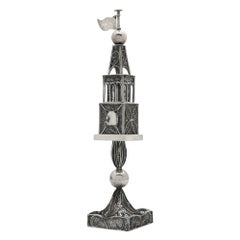Items Similar to Early German Silver Augsburg Baroque Spice Tower, Hans Jacob Ernst , circa 169
Want more images or videos?
Request additional images or videos from the seller
1 of 11
Early German Silver Augsburg Baroque Spice Tower, Hans Jacob Ernst , circa 169
$35,000
£26,393.47
€30,525.32
CA$49,104.81
A$54,583.05
CHF 28,611.27
MX$666,591.11
NOK 357,195.14
SEK 336,053.99
DKK 227,832.12
About the Item
One of the earliest spice towers we could find, it is very rare to see judaica
from the 17th century, and this 1690s spice tower is super scarce, a true gem of Baroque silver and baroque JUDAICA. the marks are very worn and also the engraved work on the actual tower has some worn places, but this tells the story of this rare survivor, the silver marks on the tower are of the city of Augsburg and the initials HIE for Hans Jacob Ernst.
the tower is worn due to its age, the roof was covered with engraved tiles that are now very lightly shown, the flags that used to adorn the roof are now all missing, some dents scratches and the base is not that straight.
The spice tower (or besamim) in used during the Havdalah, a Jewish ritual that marks the end of the holy Sabbath, in which a special candle and spice essence are used for blessing, and the spice smelling is perceived as enhancing the Jewish spirit after the pleasantry of the Shabbat before returning to daily routine. Such spice containers exist in a variety of shapes and designs.
size:
height : 14 cm/ 5.5 inch
width : 4.5 cm/ 1.77
- Dimensions:Height: 1.77 in (4.5 cm)Diameter: 5.5 in (13.97 cm)
- Materials and Techniques:
- Period:1690-1699
- Date of Manufacture:1690
- Condition:Wear consistent with age and use. Minor losses. Minor fading. the tower is worn due to its age, the roof was covered with engraved tiles that are now very lightly shown, the flags that used to adorn the roof are now all missing, some dents scratches and the base is not that straight.
- Seller Location:Tel Aviv - Jaffa, IL
- Reference Number:1stDibs: LU8130238041582
About the Seller
No Reviews Yet
Vetted Professional Seller
Every seller passes strict standards for authenticity and reliability
1stDibs seller since 2023
- ShippingRetrieving quote...Shipping from: Tel Aviv - Jaffa, Israel
- Return Policy
Authenticity Guarantee
In the unlikely event there’s an issue with an item’s authenticity, contact us within 1 year for a full refund. DetailsMoney-Back Guarantee
If your item is not as described, is damaged in transit, or does not arrive, contact us within 7 days for a full refund. Details24-Hour Cancellation
You have a 24-hour grace period in which to reconsider your purchase, with no questions asked.Vetted Professional Sellers
Our world-class sellers must adhere to strict standards for service and quality, maintaining the integrity of our listings.Price-Match Guarantee
If you find that a seller listed the same item for a lower price elsewhere, we’ll match it.Trusted Global Delivery
Our best-in-class carrier network provides specialized shipping options worldwide, including custom delivery.More From This Seller
View AllEarly 20th Century Silver Spice Tower by Yehia Yemini, Bezalel School Jerusalem
Located in Tel Aviv - Jaffa, IL
Very rare Bezalel Jerusalem silver filigree spice tower, this amazing spice Tower was Made by Yehia Yemini, who was the best filigree artist in bezal...
Category
Vintage 1920s Israeli Sterling Silver
Materials
Silver
RARE Austrian silver (ALT WIEN) Havdalah spice container, Judaica ISRAEL MUSEUM
Located in Tel Aviv - Jaffa, IL
Up for sale is this museum quality Judaica Havdalah spice container, very rare with great provenance!!
This silver spice tower was made in Vienna Austria, on the early part of the 19...
Category
Antique Early 1800s Snuff Boxes and Tobacco Boxes
Materials
Silver
Rare German Parcel-Gilt Silver Canister, Abraham Drentwett i, Augsburg 1649-1666
Located in Tel Aviv - Jaffa, IL
Important German parcel-gilt silver canister, Abraham Drentwett I, Augsburg, circa 1649-1666 Abraham Drentwett I is one of Augsburg's foremost silversmiths during the Baroque period. He was Active 1641-1666 , he is best known for having executed Queen Christina's silver throne...
Category
Antique 17th Century German Baroque Sterling Silver
Materials
Silver
Rare silver Tantur or Druze head ornament, hand made, Lebanon 18th century
Located in Tel Aviv - Jaffa, IL
up for sale is This rare and important item known as a Tantur, made from silver in the 18th century. This conical headdress was worn by Druze and some Maronite women in the mountain ...
Category
Antique 18th Century Lebanese Antiquities
Materials
Silver
Rare "Safed" kiddush cup, late 19th century Poland/ Eretz ISRAEL
Located in Tel Aviv - Jaffa, IL
This 84 silver cup was made in Europe, in Poland or parts of Poland that are in modern Russia in the 19th century, the interesting and important in this cup types is that they were s...
Category
Antique 1890s Israeli Sterling Silver
Materials
Silver
Rare silver Herb Box (Yerbera), Upper Peru, Potosí, c. 1775–90 great repoussé
Located in Tel Aviv - Jaffa, IL
Herb Box (Yerbera), Upper Peru, possibly Potosí, c. 1775–90, cast, repoussé, and chased silver,
the design is very intricate, with lions, cats and some other animals, and a women on the lid, it is made in a shell shape with a classical women on top of the lid, the body is all hand made with lions and wild cats with leafs designs, the inner part is divided into two compartments, as usually in this type of boxes. lock is not working but it is very nice and "primitive" looking.
Boxes have a long history across cultures and time. In Spanish America, containers of many types, styles, and materials were cherished as gifts. Known today as yerberas (herb boxes) or coqueras (coca boxes...
Category
Antique Late 18th Century Snuff Boxes and Tobacco Boxes
Materials
Silver
You May Also Like
A Silver Havdalah Spice Tower, Germany Circa 1900
Located in New York, NY
This exquisite German silver Havdalah spice container, crafted circa 1900, is a refined example of early 20th-century Judaica, blending delicate craftsmanship with elegant form. The ...
Category
Antique Early 1900s German Sterling Silver
Materials
Silver
Unusual Silver Filigree Spice Tower , Austria circa 1880
Located in New York, NY
Spice tower has a square base with a filigree leaf designed stem branching upward and encompassed with a ball in center. Spice container is square shaped with a floral design in the ...
Category
Antique 1880s Austrian Sterling Silver
Materials
Silver
$3,600 Sale Price
20% Off
1900s Austro-Hungarian Silver Spice Tower
Located in Jesmond, Newcastle Upon Tyne
An exceptional, fine and impressive antique Austro-Hungarian silver spice tower; an addition to our silver Judaica collection.
This exceptional antique Austro-Hungarian silver spice box has been modelled in the form of a tower.
The cuboid shaped spice box is ornamented with exceptional silver filigree work within a plain arched frame.
This impressive vessel is fitted with a hinged door embellished with contemporary engraved initials.
The upper portion of this impressive antique silver spice tower is embellished with four articulating flag designs encompassing a tapering paneled chute.
The tower's chute is ornamented with further filigree and rope twist decoration and terminating with a scalloped knop to an undulating guidon shaped flag.
The spice compartment surmounts a plain wirework style pedestal, accented with a further scalloped knop.
The square shaped foot is ornamented with filgree decoration and supported by four plain semi-spherical feet.
The hallmarks struck to the surface of this Austro-Hungarian silver spice tower include:
Maker's mark: EE (untraced)
Silver quality/purity mark: Dianakopf mark (.800, 800/1000)
Assay mark: A6 (Brno/Brünn - Czech Republic)
A spice box is used to hold sweet-smelling herbs/spices and can be fashioned in many forms. As of the 16th century a very common form is that of a tower, influenced by developments in architecture. The spice tower is used to bring comfort to a Jew as they transition through Sabbath to their new week, receiving their extra soul...
Category
Antique Early 1900s Hungarian Decorative Boxes
Materials
Silver
A Silver and Filigree Spice Tower, Austria 1880
Located in New York, NY
An exquisite example of masterful silversmithing, this Austrian spice tower is crafted of silver and intricate silver filigree, showcasing remarkable artistry and fine attention to d...
Category
Antique 1880s Austrian Sterling Silver
Materials
Silver
Antique Rare Judaica Silver Spice Tower 18th century Germany
Located in Doha, QA
This is an extremely rare and absolutely magnificent filigrane made 18th century silver spice tower. It has been crafted in Germany and hallmarked in two places with number 12. The German and Austrian hallmark in the 18th century, which was called Lot/ Loth and was used to indicate proportion of precious metal content in any metal object.
The base of the tower is square and has an intricate ornamented leaf design, the silver ball connects the base and the main part of the tower. In the middle there is a
small movable door which opens to the outside and has an engraved Hebrew letter Tav in an old font. It’s the last letter of the Hebrew Alphabet and translates as “truth”.
It symbolises truth, perfection, and completion. The tower has six gemstones on it, four red and two dark green. The design remains filigrane and fragile from the bottom to the top on all sides and at the tip of the tower there is a flag in an arrow shape.
This rare spice tower is impressive and very finely crafted. The condition for its age is excellent. The tower comes together with a beautiful original art deco wooden leather box...
Category
Antique Late 18th Century German Religious Items
Materials
Silver
Spice TowerJudaica in Silver, 20th Century
Located in Autonomous City Buenos Aires, CABA
Spice Tower in Judaic Silver, 20th Century
A beautiful spice tower of typical design, with four flags, the tower is topped with a small ball. Set on a round leg. Decorated with filig...
Category
20th Century European Art Deco Sheffield and Silverplate
Materials
Silver Plate
More Ways To Browse
German Tile
Judaica Candle
Shabbat Candle
Antique German Tile
Antique Spice Containers
Silver Spice Tower
Spice Tower
Havdalah Spice
Antique Spice Tower
Augsburg Silver
Sterling Silver Spice Tower
Silver Besamim
Sterling 169
Mother Of Pearl Sterling Flatware
Olive Picks
Silver George Iii Silver Jug
Silver Loving Cup
Silver Menu Holder
